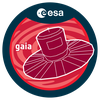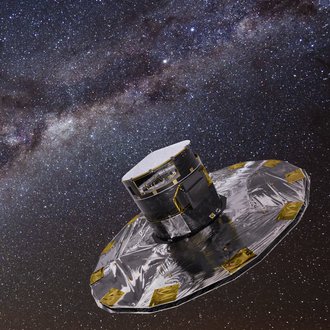Gaia


In measuring the positions, distances, space motions and physical parameters of the stars, the ESA space mission Gaia creates the most accurate map of our Milky Way. To do so, Gaia holds an astronomical field, a blue and a red photometer and a spectrograph. The Gaia data reduction is done with a dedicated software pipeline, that was developed by the Data Processing and Analysis Consortium (DPAC) just for this purpose.
On December 3rd 2020, the DPAC published the largest astronomical catalogue, that exists: the Early Data Release 3 (EDR3). Offering 1.8 billion precise object positions and motions, it helps answering astrophysical questions about the origin and evolution of our home galaxy.
The AIP is involved in the DPAC since 2007 and its contribution to the DPAC effort is focused on three topics in the coordination units 3, 6 and 9:
1.) Spectral Background Correction
The Radial Velocity Spectrograph (RVS) onboard Gaia is a slitless spectrograph. All light that enters one of the two telescopes produces an image on the detector. As a consequence, neighbouring sources can create spectra that overlap on the detector. In case a readout window was assigned all spectra, the Deblending module will disentangle their contributions. But in case one of the involved spectra was not observed, it takes part in the background light and the background correction becomes a non trivial task.
The AIP is responsible for the background correction of the RVS spectra. It thus developed the Point Background module to models the light distribution of an unobserved star on the detector. Depending on the availability of information about the source, it can model the light more or less precisely. In the ideal case, it uses brightness and position of the star, a template spectrum chosen via atmospheric parameters, the line spread function, and the radial and rotational velocities to shift and broaden the lines.
Apart from the point source background, the RVS suffers from a strong straylight, that turned out to be 40 times higher than expected. For its correction, the AIP created the software module Diffuse. It measures the diffuse background light in the unexposed edges of faint star spectra, after having removed unreliable samples, such as defect, saturated, disturbed or exposed samples. From these measurements, a two dimensional straylight map is created for solar-phase versus CCD chip position. These maps are integrated over a few satellite rotations and interpolated, such that the level of diffuse background can be read from the nearest straylight map for each star.
2.) Pipeline for Dense Regions in the Sky
In mid 2014 DPAC decided, that Gaia should observe nine very dense regions in the sky, so called crowded fields (CF), using the Service Interface Function (SIF) mode of the Gaia Sky Mapper (SM). For a long time, these images were not touched, until the DPAC set up a new working group to create a software pipeline for their data reduction in 2019. The AIP is heavily involved in this effort, as it provides both the main software developer and the manager of the SIF CF team.
Using the software module SIF CF IPD (image parameter determination), new sources are detected in the SIF CF images. Once all images are treated, the Crossmatch module creates new Gaia sources for those of the detections that fullfill the quality criteria. For these new Gaia sources, astrometry and photometry will then be calculated using adapted versions of the standard Gaia software modules.
The first aim of this effort is to improve the completenss of the Gaia Catalogues in the selected dense regions, that feature Globular Clusters, the Magellanic Clouds and the Milky Way centre. Additionally, the SIF CF sources will be used for scene building to improve the standard Gaia software in these regions.
3.) Gaia Archive
The third role of the AIP regards the pulication of the Gaia Catalogues: The AIP is an official Gaia Partner Data Centre and provides full data access for all official Gaia DPAC data releases. The complete Gaia Catalogues can be found directly on Gaia@AIP.
The AIP provides a web interface to explore and visualize the data, including a user space to store earlier search results. Results can also be shared and worked on together in user groups. The AIP research groups are supported with crossmatches of not yet published catalogs. Crossmatches with published catalogs like RAVE can be used by everyone. The AIP Gaia archive includes the StarHorse catalog and service tables like the EDR3 coordinates in the J2000 reference epoch. A special feature of the AIP Gaia Archive is the dedicated user support.
Funding: DLR, 50QG1904
Partners:
Mullard Space Science Lab London;
Astronomisches Rechen-Institut Heidelberg;
Involved AIP sections and groups:
Milky Way and the Local Volume, Dwarf Galaxies and the Galactic Halo, Supercomputing and E-Science